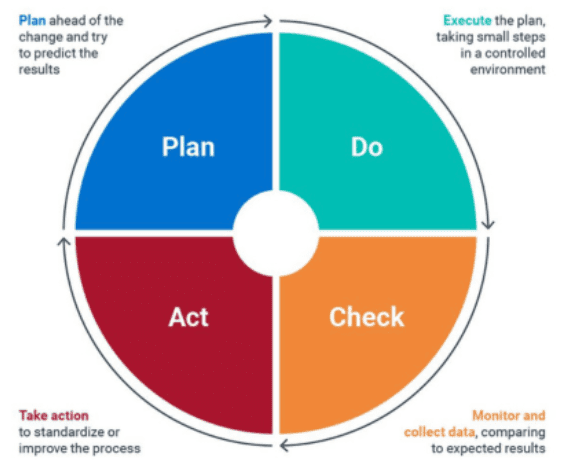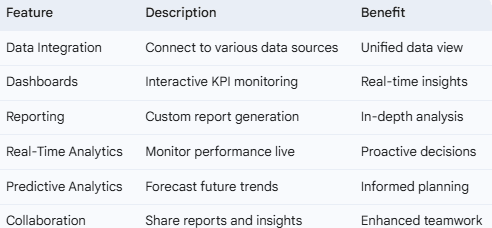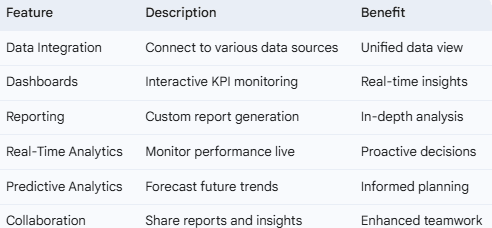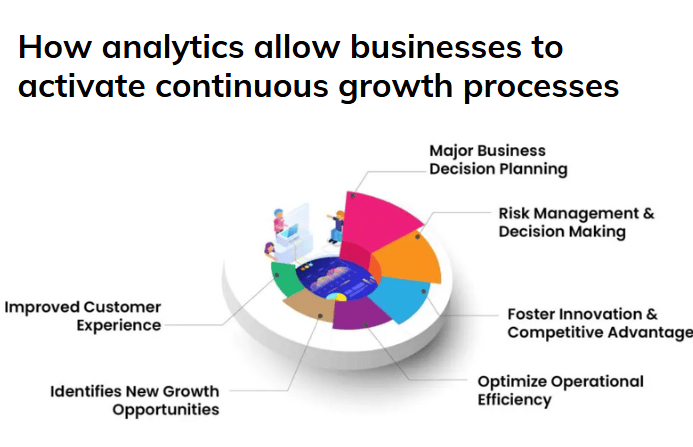
Organizations that can effectively collect, analyze, and leverage data gain a significant competitive advantage. The shift towards data-driven decision-making is transforming industries, enabling businesses to optimize operations, enhance customer experiences, and drive sustainable growth. As noted by the Financial Times, "Data is the new oil," highlighting its pivotal role in modern business strategy.
Overview of Zoho Analytics
Zoho Analytics is a powerful business intelligence and analytics platform designed to help businesses gain actionable insights from their data. It offers a comprehensive suite of tools for data integration, visualization, reporting, and analysis. With its intuitive interface and robust functionality, Zoho Analytics empowers users to explore data, identify trends, and make informed decisions.
Scope and Purpose
This article aims to explore the impact of Zoho Analytics in driving continuous improvement cycles. We will examine how businesses can leverage Zoho Analytics to identify performance gaps, set data-driven goals, and monitor progress. We will also delve into real-world use cases and implementation strategies, providing insights for businesses seeking to optimize their operations through data-driven improvement.
Understanding Continuous Improvement Cycles
Defining Continuous Improvement (CI)
Continuous improvement (CI) is a philosophy and methodology that emphasizes ongoing efforts to enhance processes, products, and services. It involves identifying areas for improvement, implementing changes, and monitoring the results. CI cycles are iterative, with each cycle building upon the previous one.
The Role of Data in CI
Data plays a crucial role in CI by providing objective evidence of performance and identifying areas for improvement. Data-driven insights enable businesses to make informed decisions and track the impact of their improvement efforts. According to Business Insider, "Data is the key to unlocking operational efficiency," highlighting its importance in CI initiatives.
Key Principles of CI Cycles
CI cycles typically involve the following principles:
- Plan: Define goals and objectives.
- Do: Implement changes and collect data.
- Check: Analyze data and evaluate results.
- Act: Take corrective actions and standardize improvements.


Zoho Analytics - Capabilities that enable businesses to improve
Zoho Analytics - Capabilities that enable businesses to improve
Zoho Analytics allows users to connect to a wide range of data sources, including databases, cloud applications, and spreadsheets. It provides tools for data cleaning, transformation, and preparation, ensuring data quality and consistency.
Data Visualization and Dashboards
The platform offers a variety of data visualization tools, including charts, graphs, and dashboards. Users can create interactive dashboards to monitor key performance indicators (KPIs) and gain real-time insights.
Reporting and Analysis Tools
Zoho Analytics provides robust reporting and analysis tools, enabling users to generate custom reports and perform in-depth analysis. This includes features such as pivot tables, drill-down analysis, and trend analysis.
Real-Time Analytics and Monitoring
Real-time analytics and monitoring capabilities allow businesses to track performance and identify issues as they occur. This enables proactive decision-making and rapid response to changing conditions.
Predictive Analytics and Forecasting
Zoho Analytics offers predictive analytics and forecasting tools, enabling users to identify trends and make predictions about future performance. This includes features such as time series forecasting and regression analysis.
Collaboration and Sharing
The platform facilitates collaboration and sharing, enabling users to share reports and dashboards with colleagues and stakeholders. This promotes transparency and alignment.
Integration with Zoho Ecosystem and External Sources
Zoho Analytics integrates seamlessly with other Zoho applications, such as Zoho CRM and Zoho Books, as well as external sources like Google Analytics and Salesforce. This ensures a unified view of business data.


or US businesses, particularly SMEs and growing enterprises, Zoho Analytics serves as a powerful diagnostic tool. By visualizing key metrics and trends, businesses can pinpoint areas where performance falls short of expectations. For instance, a US-based e-commerce company might use Zoho Analytics to identify a drop in conversion rates on specific product pages or a surge in customer support tickets related to a particular product line. This granular visibility allows for swift identification of bottlenecks and opportunities for improvement. Moreover, by comparing performance against industry benchmarks, US businesses can assess their relative position and identify competitive advantages.

You can edit text on your website by double clicking on a text box on your website. Alternatively, when you select a text box a settings menu will appear. your website by double clicking on a text box on your website. Alternatively, when you select a text box
Setting Data-Driven Goals and KPIs
In the US market, where accountability and measurable results are paramount, Zoho Analytics enables businesses to set data-driven goals and KPIs. Instead of relying on gut feeling, companies can use historical data and predictive analytics to establish realistic and achievable targets. For example, a US marketing agency might use Zoho Analytics to set KPIs for client campaign performance, such as click-through rates, conversion rates, and ROI. This ensures that improvement efforts are aligned with strategic objectives and that progress is objectively measured.
Monitoring Progress and Measuring Impact
Continuous monitoring of progress is essential for validating the effectiveness of improvement initiatives. Zoho Analytics provides real-time dashboards and automated reports, allowing US businesses to track KPIs and identify deviations from expected performance. For example, a US manufacturing company might use Zoho Analytics to monitor production efficiency, track defect rates, and analyze downtime. This continuous monitoring enables timely interventions and ensures that improvements are sustained over time.
Facilitating Data-Driven Decision Making
In the fast-paced US business environment, timely and informed decisions are critical. Zoho Analytics empowers businesses to make data-driven decisions by providing access to relevant insights and analytics. For instance, a US retail chain might use Zoho Analytics to analyze sales data, identify customer preferences, and optimize inventory levels. This ensures that decisions are based on facts rather than assumptions, reducing risk and improving outcomes.
Fostering a Culture of Continuous Improvement
For US organizations, fostering a culture of continuous improvement requires empowering employees with data and insights. Zoho Analytics enables businesses to democratize data access, making it available to employees across departments. This encourages a culture of data literacy and empowers employees to identify and implement improvements. For example, a US software company might use Zoho Analytics to create dashboards that track team performance and project progress, fostering a culture of accountability and continuous learning.
Use-cases in context to driving improvement cycles with Zoho Analytics
Sales and Marketing Performance Analysis
US businesses in sales and marketing leverage Zoho Analytics to track campaign performance, analyze customer behavior, and optimize marketing spend. For instance, a US-based SaaS company might use Zoho Analytics to monitor website traffic, lead generation, and customer acquisition costs. This enables them to identify high-performing campaigns and allocate resources effectively.
Financial Performance Monitoring and Analysis
Financial performance is a critical indicator of business health. US businesses use Zoho Analytics to monitor revenue, expenses, and profitability. For example, a US restaurant chain might use Zoho Analytics to track sales by location, analyze food costs, and monitor labor expenses. This enables them to identify areas for cost reduction and revenue growth.
Operational Efficiency Improvement
Operational efficiency is essential for competitiveness. US businesses use Zoho Analytics to identify bottlenecks, streamline processes, and optimize resource utilization. For instance, a US logistics company might use Zoho Analytics to track delivery times, analyze fuel consumption, and optimize routes. This enables them to improve delivery efficiency and reduce operational costs.
Customer Experience Analysis
Customer experience is a key differentiator in the US market. US businesses use Zoho Analytics to analyze customer feedback, track customer satisfaction, and identify areas for improvement. For example, a US hotel chain might use Zoho Analytics to analyze customer reviews, track guest satisfaction scores, and identify common complaints. This enables them to enhance the guest experience and improve customer loyalty.
Supply Chain Optimization
Supply chain optimization is crucial for managing inventory, reducing costs, and ensuring timely delivery. US businesses use Zoho Analytics to track inventory levels, analyze supplier performance, and optimize logistics. For instance, a US manufacturing company might use Zoho Analytics to monitor inventory turnover, track supplier lead times, and analyze shipping costs. This enables them to optimize inventory levels and improve supply chain efficiency.
Industry-Specific Examples (Retail, Manufacturing, Services)
- Retail: US retailers use Zoho Analytics to analyze sales trends, optimize inventory, and personalize customer experiences.
- Manufacturing: US manufacturers use Zoho Analytics to monitor production efficiency, track quality control, and optimize supply chains.
- Services: US service providers use Zoho Analytics to track service delivery, analyze customer feedback, and optimize resource allocation.
Planning and Strategy
For US businesses, successful implementation of Zoho Analytics requires a clear plan and strategy. This involves defining business objectives, identifying key metrics, and establishing data governance policies. It's crucial to align analytics initiatives with strategic goals and ensure that data is used to drive meaningful improvements.
Data Governance and Quality
Data governance and quality are essential for ensuring the accuracy and reliability of analytics. US businesses should establish clear data governance policies, implement data quality checks, and ensure data security and compliance. This includes defining data ownership, establishing data standards, and implementing data validation processes.
User Training and Adoption
User training and adoption are critical for maximizing the benefits of Zoho Analytics. US businesses should provide comprehensive training to employees, create user guides, and establish a support system. This ensures that employees can effectively use the platform and leverage data insights.
Integrating with Existing Systems
Integrating Zoho Analytics with existing systems, such as CRM and ERP, is essential for ensuring a unified view of business data. US businesses should leverage APIs and integration tools to connect Zoho Analytics with their existing data sources. This ensures seamless data flow and eliminates data silos.
Best Practices for Data Analysis and Reporting
US businesses should adopt best practices for data analysis and reporting, including using clear and concise visualizations, providing actionable insights, and ensuring data accuracy. This includes creating interactive dashboards, generating custom reports, and using data storytelling techniques.
Zoho Analytics empowers US businesses to drive continuous improvement through data-driven insights. By leveraging its robust features and functionalities, businesses can identify performance gaps, set data-driven goals, and monitor progress. Implementing Zoho Analytics effectively requires a clear plan, strong data governance, and user training. To know more or discuss any specifics or on how Zoho Analytics can be used across teams with tailored solutions for your business, reach out to us today.


